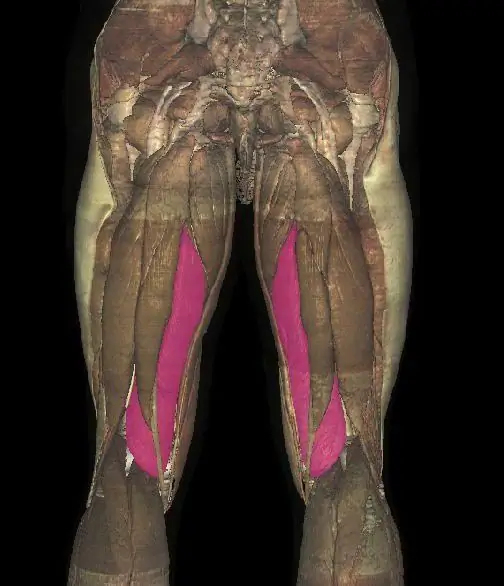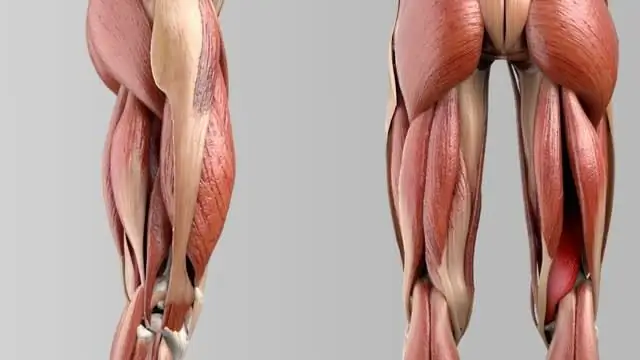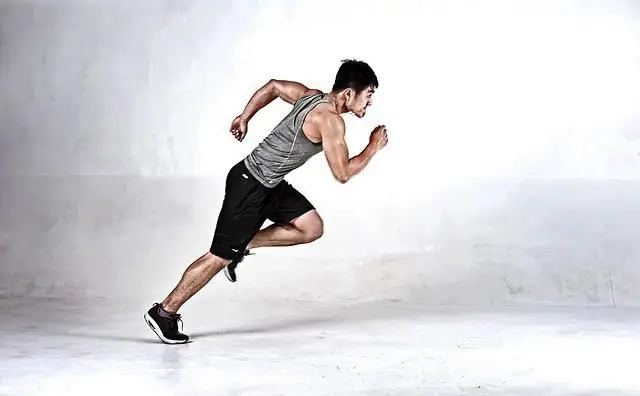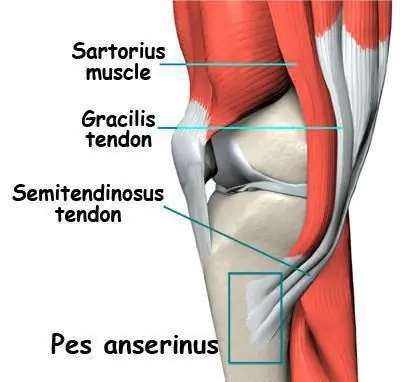- Author Curtis Blomfield [email protected].
- Public 2023-12-16 20:44.
- Last modified 2025-01-23 17:01.
The muscles of the thigh surrounding the femur, depending on the location, are divided into several groups: anterior, posterior and medial. The back group is responsible for upright and straightening of the body, extension of the hips in the hip joints and flexion of the legs in the knee joints.
The rear group consists of the following muscles:
- biceps;
- semitendinosus and semimembranosus muscles.

Location
The semimembranosus femoris is located under the semitendinosus. The muskulus semimembranosus (semimembranous muscle) begins with the lamellar tendon, which makes up its entire upper part, attaching its upper part to the ischial tuberosity, and then descends along the medial (inner) edge of the thigh. The terminal (distal) tendon of the semimembranosus muscle splits in the area of the lower attachment into three tendon bundles that form deep crow's feet on each of the thighs.

One ofbundles are attached to the fascia that covers the popliteal muscle, the second - to the internal condyles of the tibial bones (tibia) on both legs, the third, wrapping to the back wall of the knee joint, is part of the posterior oblique popliteal ligament.
Where the tendon of the muscle is divided into several bundles, the synovial bag (bursa muskulus semimembranosi) of the semimembranosus muscle is located.
Functions
The semimembranosus muscle performs a number of important functions, providing movement of the lower limb in the hip and knee joints:
- Bends the legs at the knee joints.
- Rotation (rotation) of the lower legs inward with bent knees (the muscle protects the synovial membrane from pinching by pulling the capsule of the knee joints).
- Extension of the hips at the hip joints.
- Tonic muscle.
- If the shins are secured, then the semimembranosus muscles, together with the gluteus maximus muscles, are responsible for the extension of the torso.

Nutrition and innervation
The semimembranosus muscle is supplied with blood by the artery that wraps around the femur, popliteal and perforating arteries.
The muscle is innervated by the tibial nerve.
Disorders of the semimembranosus muscle

- Injuries - sprain in three degrees of severity, including partial and complete rupture.
-
Tendopathy is a pathology that is manifested by painful sensations in the back of the kneejoint, aggravated after climbing inclined surfaces, long running, as well as bending the knee joints with resistance. In this case, the maximum pain is determined in the places of attachment of the tendons on the posteromedial surface of the tibia slightly below the border of the joint. Between the capsule of the knee joint, the medial part of the gastrocnemius muscle and the tendon is a bag, inside which chronic bursitis can develop. It is necessary to carry out differential diagnostics with intra-articular pathologies. Treat tendopathies of the semimembranosus muscle similarly to tendopathies of other localizations.
- Insercinitis in the crow's foot area is manifested with increased external rotation or when you try to turn the knee inward with a fixed lower leg (gymnastics, football, skiing). Clinical manifestations: increasing local swelling, pain during palpation, which increase when trying to remove the lower leg from its forced position of internal rotation. Most often, damage to the crow's foot is combined with damage to other stabilizing structures of the knee joint. Differential diagnosis of this pathology should be carried out with damage to the internal meniscus (its posterior horn) and bursitis in this area.
-
Cysts of the popliteal fossa (Becker's cyst) is an inflammatory process in the area of the mucous bag of the semimembranosus and gastrocnemius muscles (the presence of such bags occurs in 60% of he althy people and is not a deviation from the norm). Clinically, the cyst appears as a densely elastic tumor.in the upper part of the popliteal fossa, swelling, an increase in size (due to which the surrounding structures are compressed), discomfort, pain and restriction of movement. More often, a cyst occurs a second time as a result of overstretching of the bag with fluid in chronic inflammation of the knee joint, which has a different etiology (rheumatism, tuberculosis, various injuries, osteoarthritis, and others).






